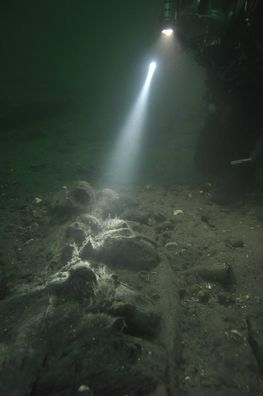Over the past two weeks, the Viking Ship Museum’s maritime archaeologists have been busy with a detailed study of the first of two wooden shipwrecks in the Fehmarn Belt. The archaeological investigations are being conducted prior to construction work on the fixed Fehmarn Belt link.
An undisturbed shipwreck
The remains of a ship, which may have sunk during a naval battle in 1644, were found during maritime archaeological investigations in 2008, and extensive measures were taken to keep the find’s discovery secret. Archaeologists succeeded in keeping the wreck’s existence and location unknown, and thus were the first divers on the site.
It is rare that maritime archaeologists have the opportunity to explore a completely undisturbed shipwreck. And although the archaeologists expected to make several interesting discoveries, the quantity of timber preserved, as well as the presence of numerous cannons and other artefacts, has surprised them.
“We were almost shocked at the extent of ship timber and cannons that criss-cross the seabed. Almost like a game of pick-up-sticks. And not only that – ceramic jars, a large metal cauldron, several layers of thick rope, parts of the ship’s rigging, ammunition and much more of the ship’s inventory are also visible on the seabed. Some of these cannons lie on top of each other, and may have come from a higher gun deck that over time collapsed as the wreck has degraded. In addition, several of the cannons lie near the carriages, or raperts, on which they were mounted,” reports project manager Jørgen Dencker, curator and maritime archaeologist from the Viking Ship Museum in Roskilde, Denmark.
The investigation begins
The first task for the maritime archaeologists is to sort out the chaotic tangle of fallen timbers, cannons, ropes and other artefacts. Below these finds are the intact remains of the ship – but its size and the extent of its preservation in the sediment are not yet known. So far, the archaeologists, to their great delight, have located some coherent ship parts, suggesting that at least one of ship’s decks is preserved.
“In most big wrecks in Danish waters, it is usually only the bottom of the vessel with ballast stones that is preserved. The Fehmarn Belt wreck is a real gem, a treasure trove, that must be properly treated and its many sensitive and very diverse finds recovered, so it is possible to preserve it for the future,” explains Jørgen Dencker.
Two shipwrecks – a coast-to-coast project
The maritime archaeologists will work on documenting the wreck in Danish waters for three more weeks. Afterwards they will move to German waters, and in cooperation with archaeologists from Archäologisches Landesamt Schleswig-Holstein, investigate the other shipwreck. This wreck is probably the Danish warship Lindormen, which sank in October 1644 during a naval battle against a combined Swedish-Dutch fleet. The position of the wreck has been widely known for a number of years and the archaeologists therefore expect that it has been partially looted by sports divers. It is not yet known if the two wrecks stem from the same sea battle, or went down in different engagements.
Both wrecks lie at around 24 metres depth, in a heavily trafficked area where ships pass en masse. Therefore, the investigation is conducted as an offshore diving project, which calls for some important safety requirements. Diving takes place from the 80-meter working vessel VINA, operated by JD Contractor A/S of Holstebro, where a total of 15 offshore divers – nine maritime archaeologists and six divers from JD Contractor – live and work during the combined eight-week investigation.
Future preservation of the shipwrecks
Both shipwrecks are protected by Danish and German laws. The investigation’s goal is to find out the extent of each wreck site on the seabed in order to establish a safety zone around it, so that it is not destroyed by the anchors and stabilizers of the huge vessels that will be used for construction of the fixed Fehmarn Belt link. It is not a question of removing all loose finds from the wrecks, or salvaging the finds in their entirety, but a clarification of how the wreck can best be preserved for the future.
“The project is one of the largest maritime archaeological investigations conducted in Scandinavia in many years and the coming weeks mean hard, long hours, 7 days a week, where we will have wrested from the depths the data we need to preserve the wrecks for the future and find out to which period of Danish history the wrecks belong,” concludes Jørgen Dencker.
It is possible to follow the investigation of the two wrecks on the Viking Ship Museum’s website, which is updated by archaeologists with images of each day’s discoveries.
Translated by Athena Trakadas
![[Translate to english:] Bjærgning af kobberkarret, der blev fundet ved det første dyk på skibsvraget. Foto: Vikingeskibsmuseet [Translate to english:] Bjærgning af kobberkarret, der blev fundet ved det første dyk på skibsvraget. Foto: Vikingeskibsmuseet](/frontend/Fotoarkiv-andre/2599-cd-0811.jpg)
